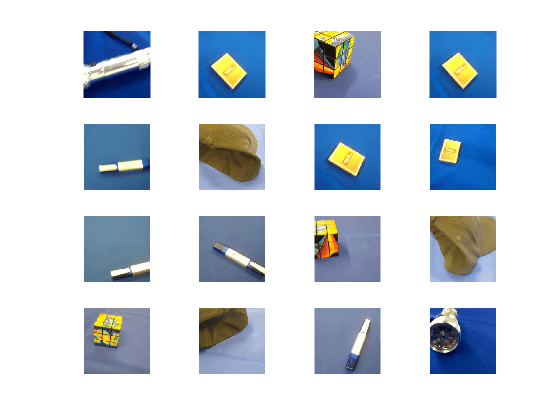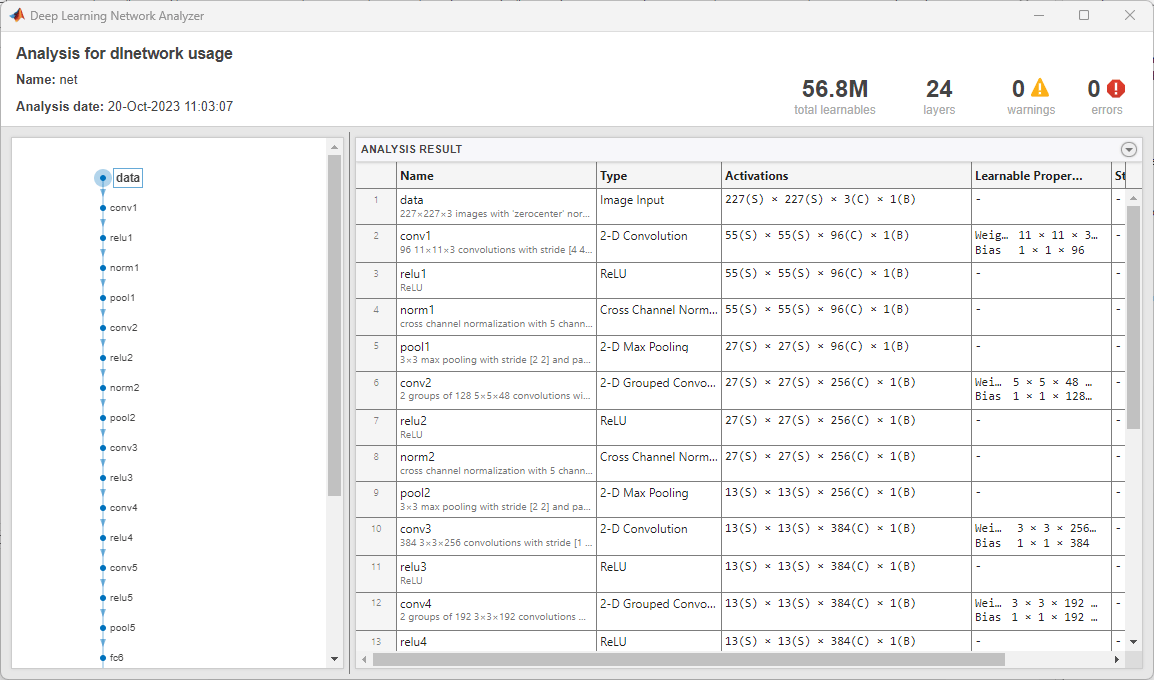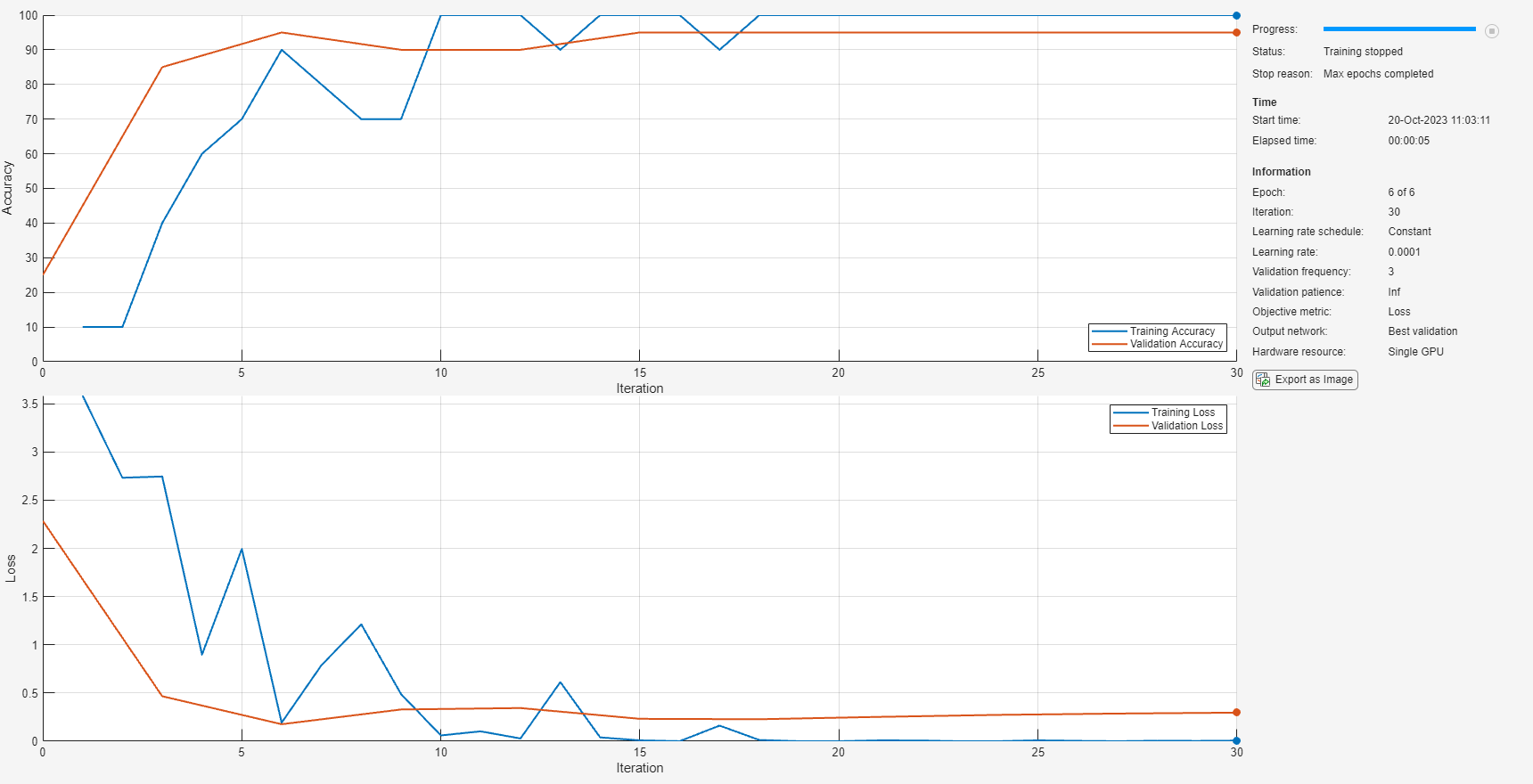Transfer Learning Using AlexNet
This example shows how to fine-tune a pretrained AlexNet convolutional neural network to perform classification on a new collection of images.
AlexNet has been trained on over a million images and can classify images into 1000 object categories (such as keyboard, coffee mug, pencil, and many animals). The network has learned rich feature representations for a wide range of images. The network takes an image as input and outputs a label for the object in the image together with the probabilities for each of the object categories.
Transfer learning is commonly used in deep learning applications. You can take a pretrained network and use it as a starting point to learn a new task. Fine-tuning a network with transfer learning is usually much faster and easier than training a network with randomly initialized weights from scratch. You can quickly transfer learned features to a new task using a smaller number of training images.

Load Data
Unzip and load the new images as an image datastore. imageDatastore automatically labels the images based on folder names and stores the data as an ImageDatastore object. An image datastore enables you to store large image data, including data that does not fit in memory, and efficiently read batches of images during training of a convolutional neural network.
unzip('MerchData.zip'); imds = imageDatastore('MerchData', ... 'IncludeSubfolders',true, ... 'LabelSource','foldernames');
Divide the data into training and validation data sets. Use 70% of the images for training and 30% for validation. splitEachLabel splits the images datastore into two new datastores.
[imdsTrain,imdsValidation] = splitEachLabel(imds,0.7,'randomized');This very small data set now contains 55 training images and 20 validation images. Display some sample images.
numTrainImages = numel(imdsTrain.Labels); idx = randperm(numTrainImages,16); figure for i = 1:16 subplot(4,4,i) I = readimage(imdsTrain,idx(i)); imshow(I) end

Load Pretrained Network
Load a pretrained AlexNet network and the corresponding class names. This requires the Deep Learning Toolbox™ Model for AlexNet Network support package. If this support package is not installed, then the software provides a download link. For a list of all available networks, see Pretrained Deep Neural Networks.
classNames = categories(imdsTrain.Labels); numClasses = numel(classNames)
numClasses = 5
net = imagePretrainedNetwork("alexnet",NumClasses=numClasses); net = setLearnRateFactor(net,"fc8/Weights",20); net = setLearnRateFactor(net,"fc8/Bias",20);
Use analyzeNetwork to display an interactive visualization of the network architecture and detailed information about the network layers.
analyzeNetwork(net)

The first layer, the image input layer, requires input images of size 227-by-227-by-3, where 3 is the number of color channels.
inputSize = net.Layers(1).InputSize
inputSize = 1×3
227 227 3
Train Network
The network requires input images of size 227-by-227-by-3, but the images in the image datastores have different sizes. Use an augmented image datastore to automatically resize the training images. Specify additional augmentation operations to perform on the training images: randomly flip the training images along the vertical axis, and randomly translate them up to 30 pixels horizontally and vertically. Data augmentation helps prevent the network from overfitting and memorizing the exact details of the training images.
pixelRange = [-30 30]; imageAugmenter = imageDataAugmenter( ... 'RandXReflection',true, ... 'RandXTranslation',pixelRange, ... 'RandYTranslation',pixelRange); augimdsTrain = augmentedImageDatastore(inputSize(1:2),imdsTrain, ... 'DataAugmentation',imageAugmenter);
To automatically resize the validation images without performing further data augmentation, use an augmented image datastore without specifying any additional preprocessing operations.
augimdsValidation = augmentedImageDatastore(inputSize(1:2),imdsValidation);
Specify the training options. For transfer learning, keep the features from the early layers of the pretrained network (the transferred layer weights). To slow down learning in the transferred layers, set the initial learning rate to a small value. In the previous step, you increased the learning rate factors for the fully connected layer to speed up learning in the new final layers. This combination of learning rate settings results in fast learning only in the new layers and slower learning in the other layers. When performing transfer learning, you do not need to train for as many epochs. An epoch is a full training cycle on the entire training data set. Specify the mini-batch size and validation data. The software validates the network every ValidationFrequency iterations during training.
options = trainingOptions("sgdm", ... MiniBatchSize=10, ... MaxEpochs=6, ... Metrics="accuracy", ... InitialLearnRate=1e-4, ... Shuffle="every-epoch", ... ValidationData=augimdsValidation, ... ValidationFrequency=3, ... Verbose=false, ... Plots="training-progress");
Train the neural network using the trainnet function. For classification, use cross-entropy loss. By default, the trainnet function uses a GPU if one is available. Training on a GPU requires a Parallel Computing Toolbox™ license and a supported GPU device. For information on supported devices, see GPU Computing Requirements (Parallel Computing Toolbox). Otherwise, the trainnet function uses the CPU. To specify the execution environment, use the ExecutionEnvironment training option.
net = trainnet(augimdsTrain,net,"crossentropy",options);
Classify Validation Images
Classify the validation images. To make predictions with multiple observations, use the minibatchpredict function. To convert the prediction scores to labels, use the scores2label function. The minibatchpredict function automatically uses a GPU if one is available. Using a GPU requires a Parallel Computing Toolbox™ license and a supported GPU device. For information on supported devices, see GPU Computing Requirements (Parallel Computing Toolbox). Otherwise, the function uses the CPU.
scores = minibatchpredict(net,augimdsValidation); YPred = scores2label(scores,classNames);
Display four sample validation images with their predicted labels.
idx = randperm(numel(imdsValidation.Files),4); figure for i = 1:4 subplot(2,2,i) I = readimage(imdsValidation,idx(i)); imshow(I) label = YPred(idx(i)); title(string(label)); end

Calculate the classification accuracy on the validation set. Accuracy is the fraction of labels that the network predicts correctly.
YValidation = imdsValidation.Labels; accuracy = mean(YPred == YValidation)
accuracy = 0.9500
For tips on improving classification accuracy, see Deep Learning Tips and Tricks.
References
[1] Krizhevsky, Alex, Ilya Sutskever, and Geoffrey E. Hinton. "ImageNet Classification with Deep Convolutional Neural Networks." Advances in neural information processing systems. 2012.
[2] BVLC AlexNet Model. https://github.com/BVLC/caffe/tree/master/models/bvlc_alexnet
See Also
imagePretrainedNetwork | dlnetwork | trainingOptions | trainnet | analyzeNetwork